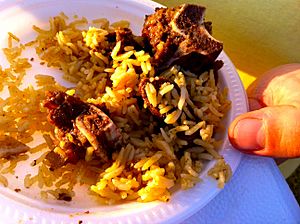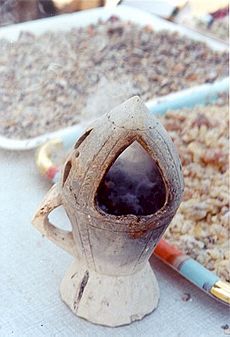Somali cuisine facts for kids
Somali cuisine is the traditional food of the Somali people who live in the Horn of Africa. Somali food has some influences from other countries, mostly because of trade. However, it also changes from one region to another within Somalia. This makes it a mix of different Somali cooking styles. It shows Somalia's long history of trading with other nations. Some famous Somali dishes include Kimis/Sabaayad, Canjeero/Lahoh, Xalwo (Halva), Sambuusa (Samosa), Bariis Iskukaris, and Muqmad/Odkac.
It's important to know that Muslims in Somalia do not eat pork. This is because of Sharia, which is Islamic law.
Contents
Starting the Day: Somali Breakfasts
Breakfast (Quraac) is a very important meal for Somalis. They often begin their day with Somali style tea (shaah/shaax) or coffee (qaxwa). The tea is made from black tea leaves. It can be served plain (shaah rinji). Or, it can be flavored with spices like ginger, cardamom, and cinnamon. Milk is added after the tea is brewed. This spiced milk tea is called shaah cadeys.
The main breakfast dish is usually a pancake-like bread called canjeero or lahoh. This bread comes from Somalia. People eat it in many ways. Often, it's eaten with Honey and Ghee or Olive oil or Sesame oil. Then, they drink a cup of tea. Sometimes, Canjeero is broken into small pieces and mixed with Somali Ghee (Subag) and sugar. For children, it is mixed with tea and Sesame oil or Olive oil (Macsaro) until it becomes soft and mushy.
People might also have a side dish with their Canjeero. This could be liver (usually beef), goat meat (hilib ari), or small pieces of beef cooked in soup (suqaar). Another option is odkac. This dish has small, dried pieces of beef, goat, or camel meat, boiled in ghee. Somali Canjeero is different from Ethiopian Injera. It is smaller, thinner, and tastes sweeter. It can also be eaten with a stew (Maraq) or soup.
- Sabaayad or Kimis/Cesh is another type of flatbread. It is similar to the Paratha from Indian cuisine. For lunch, Kimis/Sabaayad is sometimes eaten with Somali Curry, Soup, or Stew.
- Muufo is a Somali flatbread popular in South Somalia. It is usually eaten with stews and soup. Sometimes, it's eaten for breakfast with Honey/Sugar, Sesame oil, Subag, and Black tea.
- Mushaari or Boorash (porridge) is eaten all over Somalia. It is served with butter, nuts, and sugar.
- A sweeter, slightly oily version of Canjeero is called Malawax or Malawah. It is like a crepe. This is a common part of most home-cooked meals. It is usually eaten for breakfast with Tea, similar to Canjeero.
Hearty Meals: Somali Lunches
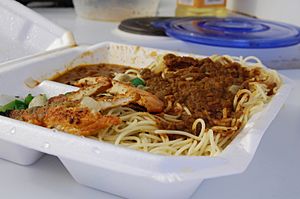
Lunch (qado) is often a big, main meal. It usually features pasta (baasto) or rice (Bariis iskukaris). These are spiced with cumin (kamuun), cardamom (heyl), cloves (dhegayare), and sage. The use of pasta, like spaghetti, came from the Italians. Somali pasta is often served with a thicker stew than Italian pasta sauce. Just like with rice, it is often served with a banana on the side.
Spaghetti can also be served with rice. This creates a special dish called "Federation". This dish usually has equal amounts of rice and spaghetti. They are placed on opposite sides of a large oval plate. Then, different stewed meats and vegetables are layered on top. It is served with salad and sometimes a banana. People think the name "Federation" comes from combining two dishes. It also refers to the large amount of food. You won't usually find this dish in a Somali home. This is because it's not common to cook both rice and pasta for one meal. Instead, people usually order it from traditional Somali restaurants. This is why it's considered a special dish.
In Somalia, many people also enjoy some Arab foods. These include Ful (fava beans) with Kimis or Canjeero. They also eat Hummus. Other dishes are Falafel with Hummus, or eaten with Pita bread, salad, and hummus, like a sandwich.
Another popular dish in the south is iskukaris. This is a Hot pot (maraq) made of rice, vegetables, and meat. It is a national favorite. Besides many hot pot styles, rice is usually served with a banana. In Mogadishu, steak (Busteeki) and fish (Kalluun/Mallaay) are widely eaten.
Southern Somalis often eat a thick cornmeal called Soor. This is usually served with stews or soup.
Another common Cornmeal dish is Asida”. It is mashed with fresh milk, butter, and sugar. Or, it can be served with a hole in the middle filled with maraq or olive oil.
A type of flatbread is sabaayad/kimis/cesh. Like the rice, it is served with maraq and meat. Somali sabaayad is often a bit sweet. It is cooked in a little oil.
Popular drinks at lunch are balbeelmo (grapefruit), raqey (tamarind), and isbarmuunto (lemonade). In Mogadishu, fiimto (Vimto) and laas (lassi) are also common. In the northwest, people prefer cambe (mango), seytuun (guava), and tufaax (apple).
Bariis iskukaris is also very popular. This rice dish is cooked and fried with onions and meat. Then, it's mixed with a Somali spice blend called xawaash. This blend has cumin, coriander, turmeric, cardamom, black pepper, cloves, and nutmeg. It is traditionally served at Somali weddings.
Evening Meals: Somali Dinners

Dinner (casho) in Somalia is served quite late, sometimes as late as 9 pm. During Ramadan, the evening meal often comes after special prayers, sometimes as late as 11 pm. Cambuulo is a common dinner dish. It is made from well-cooked azuki beans mixed with butter and sugar. The beans, called digir, can take up to five hours to cook slowly on the stove. Qamadi (wheat) is also used. It can be cracked or whole. It is cooked and served just like the azuki beans.
Rooti iyo xalwo is another dinner dish. It consists of slices of bread served with a sweet, gelatin-like treat. Muufo, a type of cornbread, is made from maize. It is baked in a Tinaar (clay oven). People eat it by cutting it into small pieces. Then, they top it with sesame oil (macsaro) and sugar. Finally, they mash it together with black tea.
Before going to sleep, people often drink a glass of milk spiced with cardamom.
Quick Bites: Somali Snacks
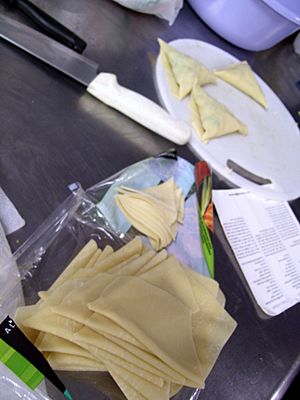
Sambusa is the Somali version of the samosa. It is a triangular snack often eaten throughout Somalia during afur (the meal to break the fast during Ramadan). Kabaab is a snack eaten in western Somalia. There are different kinds of Kabaab. For example, it can be served on sticks or skewers with vegetables. Kebabs are also eaten in Mogadishu. Another common type is made from minced meat mixed with egg and flour, then fried. This is popular in South Somalia and looks like a kofta kebab.
Other snacks include chicken and vegetable-filled rolls. There's also bajiyo, made from black-eyed peas or azuki beans, usually served with spicy sauce. These snacks, along with samosas, are very popular not just during Ramadan, but also at special events like weddings and family gatherings. Homemade chips are made from fresh potato and some black pepper. Fruits like mango (cambo), guava (seytuun), banana (moos), and orange (liinbanbeelmo) are eaten throughout the day.
Sweet Treats: Somali Desserts
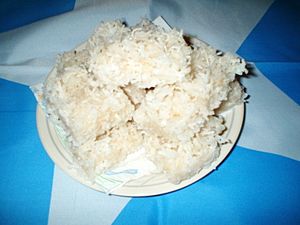

- Xalwo or Halwo is a popular sweet. It is served during special times, like Eid celebrations or wedding parties. Xalwo is made from sugar, cornstarch, cardamom powder, nutmeg powder, and ghee. Sometimes, peanuts are added to make it even better. In the south, there is a rice pudding called ruz bil laban.
- Gashaato, Kashaato, or Qumbe is a much-loved sweet. It is made from coconut, sugar, and oil, spiced with cardamom. The sugar is boiled with a little water, then cardamom is added, followed by shredded coconut.
- Lows iyo sisin is a favorite sweet in the south. It is a mix of peanuts (lows) and sesame seeds (sisin) held together by caramel. This sweet forms a bar.
- Jallaato, similar to an American ice pop, is made by freezing naturally sweet fruits with a stick in the middle. More recently in Mogadishu (Xamar), caano jallaato has become popular. This is made with milk and needs added sugar. The word jallaato comes from gelato, which is Italian for "frozen".
- Buskut or Buskud includes many different types of cookies. Some are very soft and called daardaar (meaning "touch-touch" because of their smooth, delicate feel).
- Doolshe covers many delicious kinds of cakes.
- Icun is a sweet mostly eaten by southern Somalis. It is made from sugar and flour mixed with oil. It is mainly eaten during Eid or at weddings.
- Shushumow is a fried Somali pastry with a sugary coating. It is usually made as a party snack.
- Basbousa or a cream-filled basbousa is a traditional Somali sweet cake. It has Arab influences. It is made from cooked semolina or farina soaked in simple syrup.
- In the north, there is also lokma, a sweet fried-dough pastry.
- Baklava is also eaten by some Somalis.
Many sweets are enjoyed during special times, like weddings, parties, or Eid. These include baalbaaloow, shuushuumoow, bur hindi, bur tuug, and qumbe (coconut). Qumbe is made from coconuts mixed with sugar to form a bar.
After the Meal: Fragrant Homes
Somalis traditionally make their homes smell nice after meals. Frankincense (luubaan) or a special incense (uunsi) is placed on hot charcoal. This is done inside an incense burner or censer called a dabqaad or idin. It burns for about ten minutes. This keeps the house smelling fresh for hours. The burner is made from soapstone found in certain areas of Somalia.
|
See also



